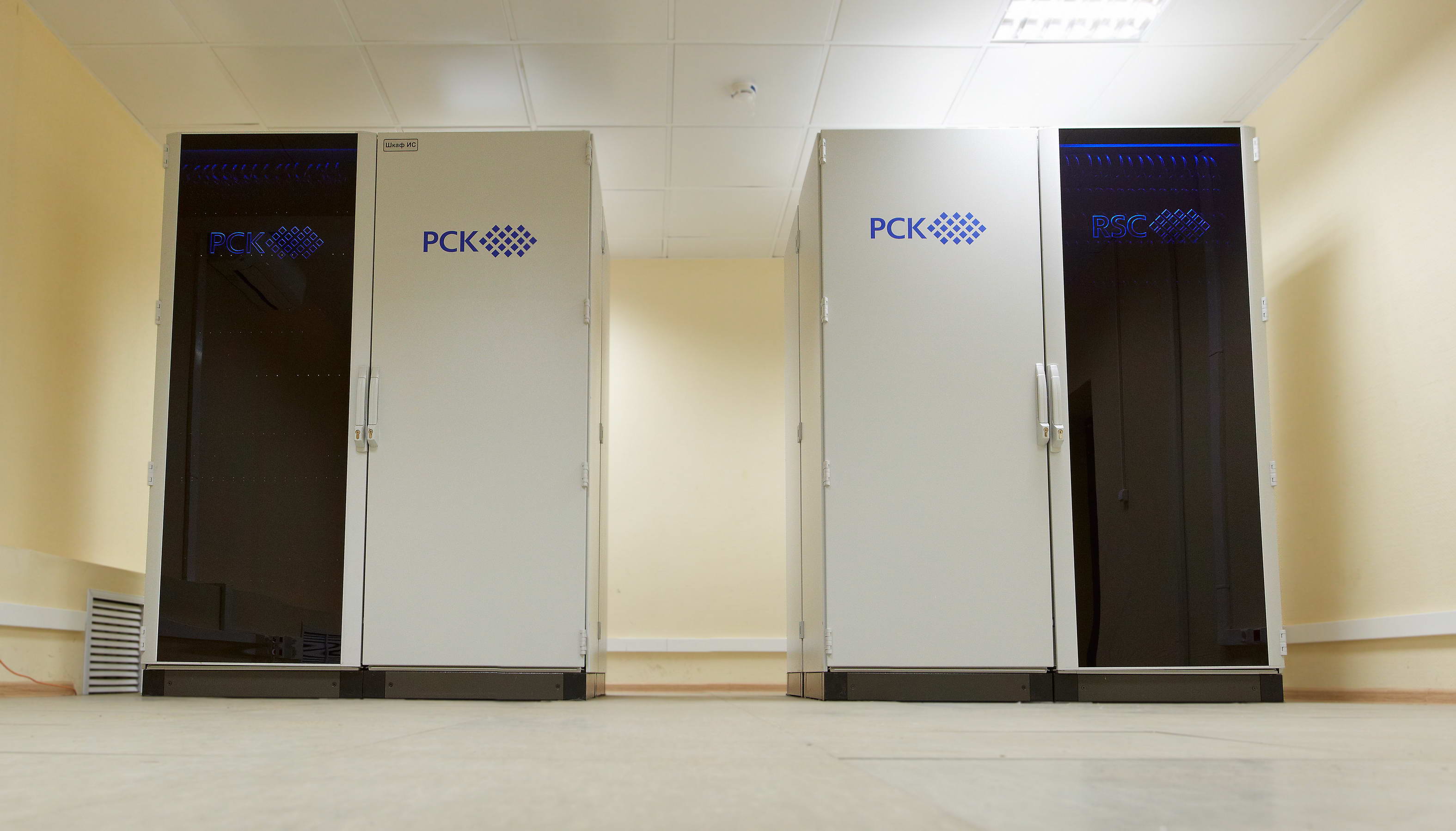Moscow, September 3, 2012. — RSC Group announces that it has doubled the performance of an energy efficient supercomputer developed by its specialists to solve most complex scientific tasks in I-SCALARE laboratory (Intel super computer applications laboratory for advanced research) at Moscow Institute of Physics and Technology (MIPT). The laboratory was established on the basis of MIPT as a part of a Russian government’s grant in 2010. Now, due to the performance doubled to 83.14 TFLOPS (trillion floating point operations per second), Russian scientists can perform a wider research and achieve further success in modeling of virus behavior and creating new pharmaceuticals to fight many dangerous diseases. The project is implemented with participation of MIPT and Intel Corporation, and RSC Group has developed and installed the innovative computing cluster based on RSC Tornado advanced architecture and best-performing Intel® Xeon® E5-2690 server processors.
The contract for the current upgrade of the supercomputer in I-SCALARE laboratory was concluded between RSC Technologies (a part of RSC Group) and MIPT in July. The upgraded MIPT supercomputer will be put into operation this year. The upgraded cluster consists of two computing racks containing 224 nodes based on two new generation Intel® Xeon® E5-2690 processors per node (in total 448 processors with 3,584 cores). The use of Intel® Xeon® E5-2600 family of best-performing processors became possible due to advanced direct liquid cooling, which is the basis of RSC Tornado architecture. Additionally, larger RAM capacity per node was achieved – 64 GB, which totaled to 14.3 TB of RAM for the whole system.
MIPT supercomputer was developed on the basis of RSC Tornado innovative architecture and implemented as a part of RSC DCmini product line, which ensured the solution's high flexibility and linear scalability. Since its creation, the computing cluster has already passed two upgrade stages, and its performance will increase more than 33 times (as of the moment of installing the first pilot system), while the system’s footprint is less than 4 sq. m.
Bioinformatics and pharmaceutical modeling are one of the fast-growing areas with an acute need for high-performance supercomputing calculations. The research carried out on the basis of I-SCALARE laboratory is very important, as breakthroughs in new methods of diagnosis and medical treatment, creation of new pharmaceuticals etc. are possible only through the development of new calculation methods and platforms that take into account specific nature of biological, medical and pharmaceutical tasks. Joint implementation of this project by MIPT, Intel and RSC Group’s specialists will bring the research in this area to the next level.
I-SCALARE laboratory has already achieved a number of new scientific results with the help of the supercomputer.
For example, a research team led by Prof. Roman Yefremov, Biochemistry Institute of RAS, uses I-SCALARE’s upgraded computing cluster in MIPT to carry out research in the area of constructing a new class of antimicrobial compounds based on natural lantibiotics. As a part of calculations and modeling during the project, microsecond-long trajectories of molecular dynamics (MD) for antibiotic targets (lipid II molecules) in the bacteria membrane were calculated. The upgraded supercomputer in I-SCALARE laboratory allows calculating such trajectories for systems that contain more than 50,000 atoms within just a week. For comparison, the same calculations using a computing cluster based on the previous-generation Intel® Xeon® E5450 processors actively used by Biochemistry Institute would take about 100 days. This means that thanks to the high performance of the new computing cluster the scientific results could be achieved more than 14 times as faster even before the current upgrade. The analysis of MD trajectories allowed to determine special features of the bacterial membrane structure. This year a more detailed modeling of interaction between antibiotics and lipid II in the membrane will be held using I-SCALARE’s upgraded supercomputer. In future such research could lead to the creation of a new class of antibiotics not susceptible to bacteria resistance.
The tasks of modeling the protein coat and molecular dynamics of dangerous Flaviviruses (e.g. bouquet fever virus) and the processes of their interaction with human body cells are solved with the help of I-SCALARE’s supercomputer by a research group led by Academician N. Zefirov at the chemical department of Lomonosov's Moscow State University. According to the lead researcher A. Palyutin, during the research, molecular models of virion’s membrane and a fragment of the protein coat consisting of millions of atoms were built. This gave the scientists information about three-dimensional structure of the protein virus that they could not obtain using experimental methods. Then the specialists analyzed its dynamic behavior and molecules that could bind with it and prevent Flaviviruses from conjugation with human body cells. Based on such models, a computerized search of potential conjugation inhibitors for tick-borne encephalitis virus was held and prospective compounds showing the necessary activity during in vitro tests were identified. As a part of works to design new neuroprotection substances, full-fledged NMDA receptor models were created. The modeling of its molecular dynamics in a phospholipid membrane with aquatic environment, as well as interaction with the known neuroprotectors was performed (the system includes hundreds of thousands atoms). The principles of interrelation between their structure and activity, as well as a prospective mechanism for receptor’s modulators action were studied. Based on this data, the scientists continue to search for new prospective structures having neuroprotector activity. Such structures can form a basis for medicines to cure serious neurodegenerative diseases, such as Alzheimer's disease.
Innovative computing cluster in MIPT
In 2011, as a part of a contract with MIPT, RSC Group, Russia's and CIS leading full-cycle developer and integrator of next-generation supercomputing solutions based on Intel architecture and advanced liquid cooling, has developed and installed a pilot system based on RSC Tornado advanced architecture and previous-generation Intel® Xeon® 5600 processors in I-SCALARE, a supercomputing technology laboratory that performs research in biomedicine, pharmacology and small-scale structures. This year the system was upgraded to the level of a powerful computing cluster that represents a complete RCS DCmini-class solution with a peak performance of 41.57 TFLOPS. The system holds the 20th position in the current edition of Top50 rating of most powerful supercomputers in Russia and CIS countries (as of March 2012). Now, its performance will double to reach 83.14 TFLOPS.
Innovative RSC Tornado architecture is the world’s first energy efficient supercomputing solution with advanced direct liquid cooling for generally available standard server boards based on Intel® Xeon® processors initially designed for traditional systems with air cooling of electronic components. RSC Tornado ensures flexible configuration of computing nodes with standard interfaces, and provides for simple creation of a solution for different use cases: e.g. increasing the capacity of RAM, upgrading to new processors, integration with external devices equipped with standard PCI Express interfaces.
Currently the cluster system at MIPT has a data storage system of 10 TB and a communication network implemented on the basis of a high-speed Infiniband QDR interface. RSC Tornado architecture provides for the following unique characteristics of the cluster:
• Simplicity and high reliability;
• Cost effectiveness;
• High energy efficiency – a record Power Usage Effectiveness (PUE) of less than 1.2. This means that maximum 20% of energy consumption will be used for cooling;
• Compact size and high density;
• High computing effectiveness ratio – more than 90% in LINPACK benchmark;
• High scalability;
• Compatibility with future Intel® Xeon Phi™ coprocessors.
The history of I-SCALARE laboratory creation in MIPT
In 2010, during a competition announced by the Ministry of Education and Science of the Russian Federation as a part of Russian Government’s Decree #220, Vladimir Pentkovsky, an employee of Intel Corporation, together with MIPT scientists introduced a program to study hardware and software architectures that would show maximum effectiveness when solving complex task in bioinformatics and pharmacology that require a lot of processing resources. Vladimir Pentkovsky, a famous software and hardware architecture developer, Intel research fellow, has extensive experience in creating scientific teams in Russia, USA and India. He has 40 international patents, which confirms its high authority. The project by Dr. Pentkovsky, who acted the project team leader, ranked among 40 winners and received a grant in the amount of 150 million rubles to create a laboratory in MIPT and carry out research under the proposed project. In total, over 500 applications were submitted for the contest.
Intel actively collaborates with Russian universities in the area of scientific research, implementation of new learning programs and creating an innovation ecosystem through cooperation with higher education institutions and the industry. Intel is a base organization for MIPT’s radio technology and cybernetics department, so the state-funded joint project became a logic development of such cooperation.
It is worth noting that I-SCALARE laboratory carries out both scientific and educational activities. Its employees developed a learning course to use simulators in modeling of various computing systems. Additionally, the laboratory regularly holds scientific seminars, and Vladimir Pentkovsky became a research advisor for several MIPT’s post-graduate students and undergraduates.






